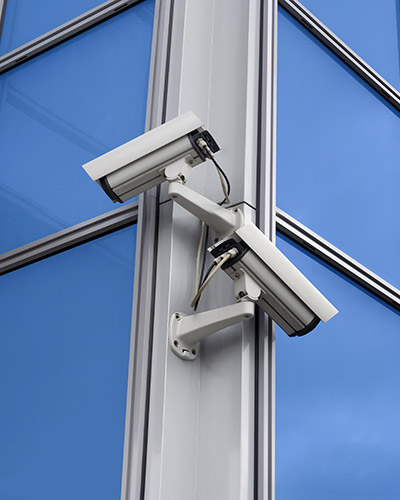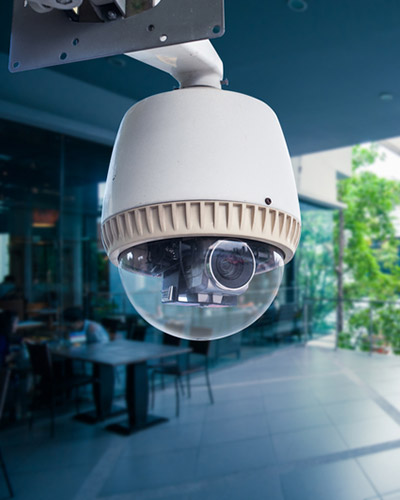
Surveillance Cameras vs Security Cameras
What’s the Difference Between Surveillance Cameras and Security Cameras?
If you’ve been thinking about adding surveillance cameras to your business, you might be wondering what the difference is between surveillance cameras and security cameras. Both types of cameras can be used to deter crime and improve safety, but they have some key differences. Here’s a closer look at the two types of cameras to help you decide which is right for your business.
What is a surveillance camera?

Copyright | Dreamstime.com
Header Photo: Copyright | Dreamstime.com
How surveillance cameras work
What is a security camera?

Copyright | Dreamstime.com
How security cameras work
Types of surveillance cameras
There are many types of surveillance cameras available, each providing different levels of security and feature sets.
- Analog cameras: Analog security cameras are the traditional type of surveillance camera, and they use coaxial cables to transmit audio and video signals. These types of cameras are relatively inexpensive but require an external power source and may not offer features such as motion detection or night vision.
- Digital IP (Internet Protocol) cameras: Digital IP cameras have become increasingly popular due to their ability to transmit images and data over the Internet. They also offer advanced features such as motion detection, night vision, and facial recognition.
- Wireless cameras: Wireless security cameras use radio frequency (RF) signals for sending video, audio, or control data between the camera and a receiver placed nearby. They are usually battery powered and require minimal wiring, making them relatively easy to install and maintain.
- PoE (Power over Ethernet) cameras: PoE cameras use an existing network connection to send power and data signals to the camera. This type of camera is useful for places with limited or no access to AC power outlets.
- PTZ (Pan-Tilt-Zoom) cameras: PTZ cameras feature advanced movement capabilities, allowing them to pan, tilt and zoom the camera’s field of view. This type of camera is perfect for monitoring large areas or focusing on specific objects within the frame.
- Dome cameras: Dome cameras are typically used in indoor environments and feature a dome-shaped housing. This design allows the camera to be rotated or tilted to get a better view of the monitored area, while also providing additional protection against vandalism.
- Bullet cameras: Bullet cameras are compact and cylindrical in design, making them ideal for outdoor environments. They have a wide field of view and often feature night vision capabilities for added security.
All types of surveillance cameras allow users to monitor various sections at once so they can easily recognize and respond to potential issues quickly and efficiently.
Types of security cameras
With advancements in technology, there has been a wide range of options available on the market for anyone looking to install a security camera.
- Box cameras: Box cameras are great for continuous visual monitoring and have adjustable lenses with different apertures and focal lengths. They are especially ideal for outdoor locations as they are designed to be weather resistant and put up against harsh temperatures.
- Panoramic cameras: Panoramic cameras can take 180- or 360-degree images by leveraging multiple lenses, making them perfect for wider views such as open parking lots.
- Wireless IP cameras: Wireless IP cameras provide users with more flexibility when installing them, since they do not require complicated wiring setup like other camera types do.
- Thermal cameras: Thermal cameras are often used for monitoring large areas, such as corporate buildings or industrial sites. They use infrared light to detect heat sources and can be used to detect suspicious activities from a distance.
- Discreet cameras: Discreet cameras are small in size and designed to blend into their environment with the purpose of catching potential criminals off-guard.
These cameras also feature night vision functionality and can easily be integrated into existing security systems.

Copyright Stnazkul | Dreamstime.com
Pros and cons of surveillance cameras
The pros and cons of surveillance cameras have been a hotly contested debate.
Installing surveillance cameras has its benefits, including:
- Prevention of crime: Surveillance cameras can deter criminals from committing crimes and help identify perpetrators if a crime does occur.
- Improved safety: Surveillance cameras can increase public safety by providing both video evidence and real-time footage to help law enforcement personnel respond quickly in the event of an emergency.
- Increased productivity: Cameras can be used to monitor employee performance and ensure that they are meeting deadlines or adhering to safety protocols.
However, there are some drawbacks to be aware of when using surveillance cameras:
- Privacy concerns: Surveillance cameras create an atmosphere of ever-present observation, and many feel this is an infringement on individual rights and personal freedom.
- Cost: Surveillance cameras are often expensive and require professional setup, so they can be cost prohibitive for some businesses or homes.
- False alarms: Surveillance cameras may trigger false alarms due to motion detection sensors if not properly calibrated. This can lead to unnecessary notifications and wasted time investigating false positives.
- Maintenance: Cameras require regular maintenance and servicing to ensure they are working properly and providing the intended security.
- Subject to abuse: Video recordings are sometimes subject to abuse if obtained illegally, which further contributes to the feeling of unease from overbearing surveillance.
Overall, surveillance cameras can be a powerful tool for monitoring and protecting an area, but it is important to weigh the pros and cons before making a decision. With proper installation and usage, surveillance cameras can help keep any environment safe and secure.
Pros and cons of security cameras
The use of security cameras certainly has both its pros and cons.
Some of the advantages:
- They can provide real-time monitoring to help identify potential threats quickly.
- They can deter crime and prevent vandalism because criminals are less likely to commit a crime if they know they are being monitored.
- They can be used in areas that do not have personnel, such as remote locations or empty parking lots, to monitor activity without having to assign a person to the task.
- They are cost effective, since they require minimal setup and can be constantly monitored with very little effort.
There are some potential disadvantages to setting up security cameras:
- They can be a target for intrusion or vandalism because criminals may try to damage or disable the system.
- Security cameras can be an invasion of privacy if used in public places without proper consent, such as a person’s home or office.
- If not properly calibrated, security cameras can trigger false alarms due to motion detection sensors.
- They can create an atmosphere of fear or unease in the area being monitored, which can have an overall negative effect on morale.
- The footage may not always be accurate due to factors like lighting and angles of view.
- They require regular maintenance and servicing to ensure they are functioning properly.
- They can be expensive to purchase and install, particularly if the area being monitored is large.
Overall, security cameras can be a useful tool in protecting an area from potential danger and providing peace of mind for those who use the space. However, it is important to consider all potential drawbacks before making any decisions on setting up a security camera system. By weighing the pros and cons, you can determine if security cameras are right for your situation.

Copyright Nuruddean | Dreamstime.com
Examples of when you would use each type of camera
For example, a dome camera is typically used to monitor larger areas in both indoor and outdoor locations, such as retail stores, warehouses, or factories. It offers a wide angle view with minimal intrusion, making it ideal for unobtrusive surveillance.
Bullet cameras are better suited for outdoor use and can be used to monitor smaller areas, such as driveways or entryways. Their shape allows them to fit in narrower spaces and they generally provide clear video footage with minimal distortion.
Discreet cameras are best used when you want surveillance without attracting attention, such as in a home or office setting. They are less visible and typically equipped with motion sensors as well as night vision capabilities, which makes them ideal for covert surveillance.
Pan-tilt-zoom cameras are best used when you need to monitor a specific area in great detail. These cameras can be remotely controlled and provide higher resolution footage than other types of security cameras. They are typically used in areas with a lot of activity, such as airports or large stadiums.
How to determine if a surveillance camera or security camera is right for your business
When considering whether to use security cameras or surveillance cameras, it is important to consider the purpose of the camera and what you need it for.
Security cameras are meant to be used as a deterrent and monitoring tool for areas that may have a higher risk of theft or vandalism, such as retail stores or parking lots. They are also commonly used in banks, businesses, and other high-traffic areas to monitor activity.
Surveillance cameras are often used for more covert monitoring purposes and may be installed in locations where security cameras are not appropriate or would be ineffective. They can also be used to monitor a specific area with greater detail without attracting attention.
By considering the purpose of the camera and what is needed from it, you can determine if a security camera or surveillance camera would be the best fit for your business.
There are several factors to consider when deciding whether to install a surveillance camera system or a security camera system:
- Assess the security risks of your business: Consider any potential threats such as theft, vandalism, or other criminal activities that could occur in your establishment and how a surveillance system might help combat them.
- Determine the size of your surveillance needs: Consider the size of the space that needs to be monitored and which type of camera would work best for it.
- Understand legal requirements: Be aware of any laws or regulations regarding surveillance cameras in your area, as well as how to properly store and use collected footage.
- Evaluate costs: Consider the upfront and ongoing costs associated with installing and maintaining a surveillance system.
- Understand potential drawbacks: Be aware of any privacy concerns or other issues related to having a surveillance camera system or a security camera system installed in your business.
By taking all these factors into consideration, you can make an informed decision on whether or not a security camera system is right for your business. Read more in our guide to video surveillance systems for business here: https://4ssgtech.com/video-surveillance-systems/

Copyright Chakrapong Worathat | Dreamstime.com
Is it better to have surveillance cameras or security cameras?
What does each type of camera system cost?
No matter which type of camera system you choose, it is important to consider the upfront and ongoing costs associated with installation and maintenance. Proper maintenance of a security camera or surveillance camera system can help ensure that your business remains safe and secure.

Copyright Pattanaphong Khuankaew | Dreamstime.com
